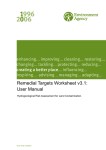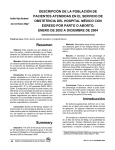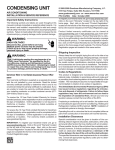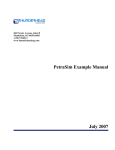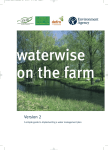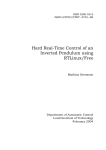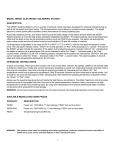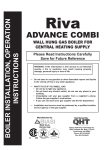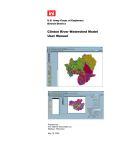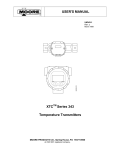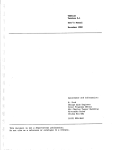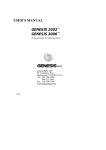Download Annex J5 - Infiltration Worksheet user manual
Transcript
How to comply with your environmental permit. Additional guidance for: Groundwater risk assessment for treated effluent discharges to infiltration systems Annex J5: Infiltration Worksheet User Manual v2.0 H1 Annex J5: Infiltration Worksheet user manual December 2014 version 2.0 1 Published by: Environment Agency Horizon House, Deanery Road Bristol BS1 5AH Tel: 0117 934 4000 Email: [email protected] www.environment-agency.gov.uk © Environment Agency All rights reserved. This document may be reproduced with prior permission of the Environment Agency. H1 Annex J5: Infiltration Worksheet user manual Pu Further copies this report are December 2014 versionof2.0 2 available from our publications catalogue: http://publications.environment-agency.gov.uk or our National Customer Contact Centre: T: 03708 506506 Further copies of this report are available from our publications catalogue: http://publications.environmentagency.gov.uk or our National Customer Contact Centre: Tel: 03708 506506 Content How to comply with your environmental permit. .................................................................... 1 Additional guidance for: .......................................................................................................... 1 Groundwater risk assessment for treated effluent discharges to infiltration systems ........... 1 Annex J5: Infiltration Worksheet User Manual v2.0................................................................ 1 Infiltration Worksheet user manual v2.0.................................................................................. 3 Obtaining and installing the InfWS .......................................................................................... 4 1.0 Overview............................................................................................................................ 5 2.0 The risk assessment approach and the site conceptual model. .................................... 8 2.1 Discharge limit values ....................................................................................................... 9 3.0 Using the individual worksheets ...................................................................................... 11 3.1 General ............................................................................................................................. 11 3.2 Introduction worksheet.................................................................................................... 12 3.3 Infiltration System worksheet........................................................................................... 13 3.4 Attenuation in Unsaturated Zone worksheet................................................................... 18 3.5 Dilution worksheet ........................................................................................................... 23 3.6 Attenuation in the Saturated Zone worksheet ............................................................... 27 3.7 Calculated parameters..................................................................................................... 28 3.8 Summary calculations worksheet................................................................................... 34 4.0 Additional worksheets ...................................................................................................... 36 4.1 Hydrogeological Calculations worksheet ...................................................................... 36 4.2 Ammonium Conversion worksheet ................................................................................ 37 4.3 Porosity Calculator worksheet........................................................................................ 37 5.0 Degradation ....................................................................................................................... 39 5.0 Interpretation of results..................................................................................................... 40 6.0 Sensitivity analysis............................................................................................................ 41 7.0 Assessment of results ...................................................................................................... 42 References............................................................................................................................... 43 Appendix A.............................................................................................................................. 45 . H1 Annex J5: Infiltration Worksheet user manual December 2014 version 2.0 1 Summary of changes Below is a summary of changes made to this Annex since the launch in February 2011. Annex version Date Change Template version 1.2 Nov 2011 Reformatting to respond to general issues raised in the 2010 H1 public consultation. Minor review of text and layout. H1 April 2011 2.0 Dec 2014 Infiltration worksheet tool amended to represent drainage layer H1 April 2011 Error in dilution factor calculation fixed Minor review of text, layout and references H1 Annex J5: Infiltration Worksheet user manual December 2014 version 2.0 2 Introduction Infiltration Worksheet user manual v2.0 We have prepared this user manual to assist users of our Infiltration Worksheet v2.0 (InfWS). This document describes the functionality of the InfWS and gives guidance on its use including some simple tips for using and interpreting the results. The InfWS provides a means of carrying out some of the calculations behind the framework on Annex J4 Groundwater risk assessment for treated effluent discharges to infiltration systems (Environment Agency, 2011a), which forms a technical annex to our H1 Environmental Risk Assessment: Annex J groundwater (Environment Agency, 2011b). More general information on our approach to risk assessment and the underlying regulatory context and our position are set out in the following documents: Groundwater Protection: Principles and practice (GP3) (Environment Agency, 2013 or as updated). Guidelines for environmental risk assessment and management. The Stationery Office (DETR et al, 2000). We strongly recommended that you read and become familiar with the relevant sections of these documents before using the InfWS. We have developed the InfWS to help determine the risk to groundwater from discharges of treated sewage effluent via infiltration systems (such as a drainage field designed to British Standards) and it should only be used in this context. It is appropriate to use the InfWS for larger discharges (15m 3/day or more) or those which have been identified as needing to progress to a higher level of assessment (Level 2 prior examination). The InfWS should only be used by suitably experienced hydrogeologists or those fully conversant with our approach to groundwater risk assessment and the relevant legislation and guidance. The InfWS can also be used as a tool to help refine the location of the discharge, the design of the structure and the level of treatment of the effluent prior to discharge. This can be supported by the use of sensitivity analysis. The previous version of the InfWS (version 1.2) has been updated as follows: 1. The drainage blanket within an infiltration system / drainage field is now represented, which allows attenuation in the drainage blanket and unsaturated zone to be considered separately. This modification was based on research by the Irish H1 Annex J5: Infiltration Worksheet user manual December 2014 version 2.0 3 Advanced 0.4cm to right Insert paragraph before inserting section title below Environment Protection Agency 1 that suggests attenuation mainly occurs within the drainage blanket. 2. A check has been added to flag any inconsistency between the area of the drainage field entered or calculated in the ‘Infiltration’ sheet and the area calculated in the ‘Dilution’ sheet (see Table 3.4). 3. An appendix has been added which gives guidance on input values. 4. The equation used to calculate the dilution factor has been corrected. This may have resulted in minor errors. Obtaining and installing the InfWS You can download the InfWS version 2.0 from the Horizontal guidance: environmental permitting on the gov.uk website. We have prepared and tested the InfWS in Microsoft Excel 2002TM2 on the Microsoft 95/2000/XPTM operating systems. The file comprises about 570 KB and should not require any significant additional computing capability beyond that needed to run Microsoft Excel 2002TM. We recommend that a blank copy is saved as a master file and that each simulation is saved as a distinct file. In order to enable the InfWS, a number of capabilities are required in Microsoft Excel 2002TM that may not automatically be set. The InfWS calculates error functions and complimentary error functions. Before use, you will need to add these capabilities by clicking the following from the pull-down Tools menu: Tools Add-Ins Analysis ToolPak and Analysis ToolPak-VBA. You must also Enable Macros when prompted to do so. If you are working in Microsoft Excel 2007TM, you will need to add these capabilities by clicking the Office Button and then the following from the pull-down Tools menu: Excel Options Add-Ins Analysis ToolPak and Analysis ToolPak-VBA. 1 Irish Environment Protection Agency, 2005. An in vestigation into the performance of subsoils and stratified sand filters for the treatment of wastewater from on-site systems. Final Report for project 2000-MS-15-M1 (The Hydraulic Performance and Efficiencies of Different Subsoils and the Effectiveness of Stratified Sand Filters) Environmental RTDI Programme 2000-2006. 2 The worksheet is currently being tested for use on later versions of Microsoft Excel TM and other MicrosoftTM operating systems H1 Annex J5: Infiltration Worksheet user manual December 2014 version 2.0 4 Infiltration Worksheet v2.0 user manual 1.0 Overview An illustration of a typical setting for which the InfWS could be used is given in Figure 1.1 Figure 1.1 Discharge of treated effluent to infiltration systems and application of the InfWS You can use the InfWS to: calculate the area of the drainage field; calculate the average infiltration rate over the drainage field; determine attenuation within the drainage blanket and the unsaturated zone and calculate the concentration of the substance of concern at the water table; H1 Annex J5: Infiltration Worksheet user manual December 2014 version 2.0 5 Infiltration Worksheet v2.0 user manual determine the dilution factor for non-hazardous pollutants and calculate their concentration in groundwater immediately down-gradient of the drainage field; determine attenuation within the saturated zone for non-hazardous pollutants and calculate their concentration at a point down-gradient of the drainage field; and determine provisional discharge limit values. Box 1.1 contains a definition of some of the main terms used in this document. Box 1.1 Definition of standard terms Term Definition Compliance point A compliance point is a suitable point along the substance pathway between the source and a receptor at which a compliance value can be set. The compliance point may be a virtual point (for the purpose of predictive assessments) or it may be a physical monitoring point such as a borehole. In some cases the compliance point may be the receptor itself. Compliance value This is a concentration at the compliance point that should not be exceeded. Depending on the level of assessment, a compliance value may take account of some or all of the dilution and attenuation processes along the substance pathway to the receptor(s). The purpose of the selected compliance value is to provide protection to a down-gradient receptor – provided the compliance value is met the relevant environmental standard for the receptor(s) should also be met. Discharge limit value A discharge limit value is a value set as a condition in the permit to control a specified substance in the discharge with the aim of preventing the input of hazardous substances to groundwater or pollution due to the input of non-hazardous pollutants. Dilution factor The dilution factor describes the amount of dilution of the discharge by groundwater flow and is calculated from the ratio of groundwater below the drainage field and the discharge to the drainage field. Attenuation factor (drainage blanket) The attenuation factor in the drainage blanket can be calculated as the ratio between the concentration of the substance in the treated effluent and the predicted concentration at the base of the drainage blanket. Attenuation factor (unsaturated zone) The attenuation factor in the unsaturated zone can be calculated as the ratio between the concentration of the substance at the base of the drainage blanket and the predicted concentration at the base of the unsaturated zone. Attenuation factor (saturated zone) The attenuation factor in the saturated zone can be calculated as the ratio between the concentration of the substance in groundwater below the drainage field and the predicted concentration at a point downgradient of the drainage field. H1 Annex J5: Infiltration Worksheet user manual December 2014 version 2.0 6 Infiltration Worksheet v2.0 user manual Box 1.1 continued Term Definition Environmental standard The environmental standard used to derive the compliance values will depend on (a) whether the substance is a hazardous substance or a non-hazardous pollutant and (b) the use of the receptor (for example, a potable abstraction or surface water). Examples of environmental standards are: Limits of detection or where applicable a Minimum Reporting Value (MRV), MRVs are typically used to assess the discernibility of hazardous substances as a basis for deciding whether their input has been prevented; Natural background (up-gradient) quality. This might be used to assess the discernibility of hazardous substances where background concentrations are higher than detection limits or the MRV. Alternatively it might be used for non-hazardous pollutants where the natural background concentration exceeds the relevant standard such as a drinking water standard (DWS) or environmental quality standard (EQS). DWS (Drinking Water Standard) or EQS (Environmental Quality Standard). In some cases it will be appropriate to use lower concentrations than the DWS or EQS to provide satisfactory protection to a receptor. For example, it may be suitable to apply a safety factor to provide greater security to an existing drinking water supply (such as 0.75 x DWS). In other cases where the DWS or EQS represents a significantly higher concentration than the natural background quality, use of such values might represent a significant level of deterioration (for example, a DWS of 250 mg/l of chloride compared to a background concentration of for example, 30 mg/l). In these cases you may need to discuss this with us and derive a more suitable value between the MRV or background concentration and the EQS or DWS. H1 Annex J5: Infiltration Worksheet user manual December 2014 version 2.0 7 Infiltration Worksheet v2.0 user manual 2.0 The risk assessment approach and the site conceptual model. The tools selected to model a site should be appropriate to the conceptual model and the quality of the available data. Guidance on these issues is provided in: Guide to good practice for the development of conceptual models and the selection and application of mathematical models of contaminant transport processes in the subsurface. National Groundwater and Contaminated Land Centre report NC/99/38/2, Solihull (Environment Agency, 2001a). Benchmarking and guidance on the comparison of selected groundwater riskassessment models. National Groundwater and Contaminated Land Centre report NC/00/14, Solihull (Environment Agency, 2001b). You should only employ the InfWS where a robust conceptual model has been developed and you are satisfied that the calculations performed are relevant to the processes described within that conceptual model. The development of a robust conceptual model is perhaps the most important aspect in the process of successfully estimating and evaluating environmental risks. The use of any mathematical modelling tool without first developing a robust conceptual model is likely to result in meaningless output and poor decision-making. The conceptual model should be supported by valid data. Good quality site specific data is always preferred. If you use generic data it should be reliable and relevant to the site. You should document the provenance and relevance of all data included in an assessment using the InfWS and include this in any report(s) submitted to us for consideration. The InfWS should only be used when adequate site-specific data have been obtained. For further guidance on sources of information and which site-specific data are required the reader should refer to Environment Agency (2011a and 2011b). The following guidance on reviewing assessments may also be of use in preparing reports for submission as part of any application: Guidance on the assessment and interrogation of subsurface analytical contaminant fate and transport models. National Groundwater and Contaminated Land Centre report NC/99/38/1, Solihull (Environment Agency, 2001c). H1 Annex J5: Infiltration Worksheet user manual December 2014 version 2.0 8 Infiltration Worksheet v2.0 user manual 2.1 Discharge limit values Box 2.1 contains a summary of the basic calculations to determine the concentration of a substance at different points along the contaminant pathway (Figure 1.1). Box 2.2 illustrates how the discharge limit values are derived. Box 2.1 Summary calculations for determining the concentration at different compliance points Concentration at compliance point. The concentrations of substances at different points along the pathway can be calculat ed as follows: (i) Water table (attenuation in unsaturated zone only): Cwt = Ce / (AFu1 . AFu2 ) (Equation 1) (ii) Borehole adjacent to infiltration system (attenuation in uns aturated zone and dilution) Cgw = Ce / (AFu1 . AFu2 . DF) (Equation 2) (iii) Down-gradient borehole (attenuation in unsaturated and saturated zone and dilution - non hazardous pollutants only) Cdcp = Ce / (AFu1 . AFu2 . AFs . DF) (Equation 3) where: Cdcp= Concentration at down-gradient compliance point (mg/l). Concentration should be below compliance value Cgw = Concentration immediately down-gradient of drainage field point (mg/l) Cwt = Concentration at base of unsat urat ed zone (mg/l) Ce = Concentration of substance in treated effluent discharge (mg/l) AFu1 = Attenuation factor (drainage blank et) AFu2 = Attenuation factor (uns aturated zone) DF = Dilution factor AFs = Attenuation factor (sat urated zone) H1 Annex J5: Infiltration Worksheet user manual December 2014 version 2.0 9 Infiltration Worksheet v2.0 user manual Box 2.2 Discharge limit values Discharge limit values (DCL) can be calculated as follows: (i) Attenuation in drainage layer and unsaturated zone only: DCL1 = AFu1 . AFu2 . Cc (Equation 4) (ii) Attenuation in unsaturated zone and dilution DCL2 = DF . DCL1 (Equation 5) (iii) Attenuation in unsaturated and saturated zone and dilution (non hazardous pollut ants only) DCL3 = AFs . DCL2 (Equation 6) Where, DCL1-3 = Discharge limit value (these will vary depending on whether compliance point is: (DCL1) base of unsat urat ed zone; (DCL2) groundwater immediately down-gradient of drainage field; (DCL3) groundwater down-gradient of drainage field. DF = Dilution factor AFu1 = Attenuation factor (drainage blank et) AFu2 = Attenuation factor (uns aturated zone) AFs = Attenuation factor (sat urated zone) Cc = Compliance value (mg/l) (for example, water quality standard or MRV) You should regard any discharge limit values that are calculated using the InfWS as provisional. We may need to take additional information (such as, variability of leachate quality, type of treatment process, and assumptions in choice of parameter values) into account in defining the discharge limit values that will be specified as part of the environmental permit. H1 Annex J5: Infiltration Worksheet user manual December 2014 version 2.0 10 Infiltration Worksheet v2.0 user manual 3.0 Using the individual worksheets 3.1 General The InfWS incorporates 10 worksheets, which have the following functions: Table 3.1 Function of worksheets Title of worksheet Function of worksheet Introduction Brief instructions, entry of site details, assessor details, substance and environmental standard used (and its origin) to derive the compliance value for transfer to subsequent sheets Infiltration System Data entry for infiltration system including infiltration rate and area of drainage field Attenuation_unsatzone Data entry for calculating attenuation in the drainage layer and the unsaturated zone Dilution Data entry for calculating dilution factor and substance concentration in groundwater immediately down-gradient of the drainage field Attenuation_satzone Data entry for calculating attenuation factor in the saturated zone and substance concentration in groundwater down-gradient of the drainage field Summary Summary of results of calculations of impact of the discharge on groundwater and provisional discharge limit values Additional calculations Data entry and computation of simple hydrogeological calculations Ammonium calculator Data entry and conversion for different laboratory analysis of ammonium Porosity calculator Data entry and calculation of water-filled porosities Attenuation calc_sat_zone Calculation of attenuation factor in the saturated zone Data entry is only possible in eight of the worksheets (as highlighted in blue in Table 3.1). Each of these eight worksheets also presents the results of each calculation. The calculations themselves are carried out in the remaining worksheets which are provided for reference. H1 Annex J5: Infiltration Worksheet user manual December 2014 version 2.0 11 Infiltration Worksheet v2.0 user manual Each worksheet is password protected and data may only be entered in specific cells. The cells are colour-coded as detailed in Table 3.2. Table 3.2 Colour scheme for the worksheets Blue cells require data to be entered, to either perform a specified calculation, or to record site details. Data may take the form of either site details as text (on the Introduction sheet) or values for identified parameters (on all other sheets). All blue cells must be completed for each assessment type Brown cells are pull-down menus where options can be selected to allow the assessor to select a predefined option Yellow cells should be used to record the origin or source of any data used in the worksheet. Although failure to populate the ‘Source of parameter value’ cells with appropriate text will not affect the spreadsheet calculations, it is good practice to complete this task. We will expect submitted reports to include these details Grey cells contain the results of each simulation Green cells contain information derived from another part of the worksheet If you move the cursor over the red triangles at the corner of certain cells, further information is revealed on the data required or equations solved. Please also refer to Figure 3.2. 3.2 Introduction worksheet When starting a new assessment, you must complete details on the Introduction worksheet first (Figure 3.1). This worksheet is displayed for all assessment options. Data required (in blue boxes) on the Introduction worksheet include: name and address of the site being assessed; name of assessor, date that assessment was completed, and run version number; name of substance; environmental standard used to derive the compliance value; and basis for environmental standard (for example, EQS, DWS, MRV, background quality). You must complete all blue cells on the Introduction worksheet before moving onto any other worksheets. Data entered for the substance name, environmental standard, site name, assessor’s name, date of assessment and identifying run number are automatically transferred to each of the subsequent data entry sheets. These details cannot be amended H1 Annex J5: Infiltration Worksheet user manual December 2014 version 2.0 12 Infiltration Worksheet v2.0 user manual within the subsequent worksheets, and can only be modified by changing the entry on the Introduction worksheet. The Introduction worksheet also includes brief instructions on the use of the worksheet and a reminder that Microsoft Excel 2002 Tools must be enabled to allow it to calculate error functions and complimentary error functions. The worksheet will not calculate attenuation factors, unless Microsoft Excel is set-up to calculate these mathematical functions. It is necessary to undertake a separate simulation for each substance in the treated effluent. You can find guidance on selecting an appropriate environmental standard, which are typically based on background water quality, Minimum Reporting Values (MRVs), drinking water standards (DWS) or environmental quality standards (EQS), in Environment Agency 2011a and 2011b. See also Box 1.1. Figure 3.1 Data entry required on Infiltration Introduction Worksheet Details to be completed for each assessment Site Name: Site Address: Enter site name Enter site address Completed by: Date: Enter user name Enter date Substance Environmental Standard (CT) Chemical 0 mg/l Version: x.xx Origin of CT: Specify basis for standard (e.g. MRV, EQS, DWS) 3.3 Infiltration System worksheet The Infiltration System worksheet (Figure 3.2) allows you to specify the concentration of the substance in the treated effluent and to enter details of the infiltration system. Project information data (site and pollutant details) are automatically transferred to this worksheet from the Introduction worksheet. The Infiltration System worksheet provides the following options (brown cells): 1. Specify the type of treatment plant. Four options are provided: 1. Septic tank. 2. Package treatment plant. 3. Treatment plant. 4. Other. H1 Annex J5: Infiltration Worksheet user manual December 2014 version 2.0 13 Infiltration Worksheet v2.0 user manual For septic tanks and package treatment plants you can input the following information: Number of persons (p). Number of individuals served by the system. This information is used to calculate total discharge and the area of the drainage field. Water use (litres/person/day). Typical rates of sewage generation (in litres per person per day) are given in British Water Flows and Loads 4 (British Water, 2014). Percolation rate (Vp). The percolation rate should be taken from percolation tests undertaken according to BS6297:2007 + A1:2008. This rate is used together with the number of persons to calculate the area of the drainage field (See Box 3.1). 2. Discharge rate. Two options are provided: 1. Enter the discharge rate 2. Calculate discharge rate (this option is only available for septic tanks and package treatment plants (see Box 3.1). 3. Area of drainage field. Two options are provided: 1. Enter the area of the drainage field. 2. Calculated area of the drainage field (this option is only available for septic tanks and package treatment plants (see Box 3.1). A summary of the data requirements (blue cells) for this worksheet is given in Table 3.3. Depending on the options selected the worksheet will automatically grey out cells for which data entry is not required. The Infiltration System worksheet calculates the following results: Discharge rate (m3/day) based on the number of persons and water use (this option is only available for septic tanks and package treatment plants); Area of the drainage field (m2) based on the number of persons and percolation rate derived from testing (this option is only available for septic tanks and package treatment plants); Infiltration rate (m/day) over the discharge area. This rate is used in subsequent calculations. H1 Annex J5: Infiltration Worksheet user manual December 2014 version 2.0 14 Infiltration Worksheet v2.0 user manual Complete each of the blue cells – the cells coloured blue will vary depending what other parameters are selected. Data in green cells is automatically transferred from previous sheets. Click on the brown cells and use pull down menus for other options. Infiltration System Substance Compliance value or environmental standard Ammonium CT 3.90E-01 Variable Value Ce 6.00E+01 From introduction sheet mg/l From introduction sheet Calculate for ionic organic chemicals (acids) Input Parameters Standard entry Concentration of substance in substance in discharge (entering infiltration system) Unit mg/l Septic tank Type of treatment plant Water use and percolation rate (for use only with septic tanls and package treatment plants) Number of persons If the assessor moves the Water use cursor over the red triangles Percolation rate at the corner of certain cells, Specify discharge (Q1) or calculate based on use (Q2) further information is revealed Discharge rate on the data required or Calculated discharge equations solved. Source of parameter value p Vp 5.00E+01 1.80E+02 litres/person/day 1.00E+01 s/mm Calculated discharge Q2 Q1 0.00E+00 m3/d Q2 9.00E+00 m3/d Area of drainage fied and hydraulic loading Specify area of drainage field or calculate based on percolation rate The source of each value should be documented in the yellow cells on the worksheet and in any associated reports. Calculate Enter area of drainage field Calculated area of drainage field A A 0.00E+00 1.25E+02 m2 m2 Calculated infiltration rate Inf 7.20E-02 m/d The outputs from each worksheet are provided in the dark grey cells. Cells not used in the calculation are shaded out. Figure 3.2 Examples of the main functionality. The Infiltration System worksheet (which has been used as an example here) calculates the discharge and infiltration rates. It can also calculate the Area of the Drainage Field (depending on what option is selected). H1 Annex J5: Infiltration Worksheet user manual December 2014 version 2.0 15 Infiltration Worksheet v2.0 user manual Box 3.1 Standard equations for the Infiltration System worksheet The hydraulic loading or infiltration rate (Inf) is calculated from: Q A where: Inf (Equation 1) Inf = Infiltration rate through the infiltration system (m/d) Q = discharge rate to drainage field (m 3/d). A = area of drainage field (m 2) (see below) Note: The infiltration rate (Inf) should not exceed the maximum infiltration rate from BS 6297:2007 + A1:2008. This would indicate re-design of the drainage field was necessary. For some infiltration systems the design may include for storage to deal with peak flows, in these cases the infiltration rate should be set as the maximum infiltration rate. The discharge rate (Q) is calculated as follows: Q p.W (x 1 000: m 3/day to litres) (Equation 2) where: Q = discharge rate to drainage field (m 3/d). p = number of people served by the septic tank or package treatment plant W = water use per person (litres/person/day) The area of a drainage field (A) for domestic premises is calculated from (BS 6297:2007 + A1:2008): (Equation 3) A (0.25) p.Vp for septic tanks A (0.20) p.Vp for package treatment plants (Equation 4) where: A = area of drainage field (m 2) p = number of people served by the septic tank or package treatment plant Vp = percolation rate determined from percolation tests undertaken according to BS6297:2007 + A1:2008 (sec/mm) H1 Annex J5: Infiltration Worksheet user manual December 2014 version 2.0 16 Infiltration Worksheet v2.0 user manual Table 3.3 Summary of data requirements for the Infiltration System worksheet Input parameter Concentration of substance in treated effluent discharge Ce Number of persons p Water use Units Comment Other mg/l Measured or taken from an agreed reference Must be input Number of people served by the septic tank or package treatment plant litres/person/day Information on typical rates of sewage generation can be obtained from British Water (2014) Dependent on option selected Percolation rate Vp sec/mm Rate should be determined as set out in BS6297:2007 + A1:2008 Discharge rate Q1 m 3/day Measured or calculated based on number of persons or water use Dependent on option selected Area of drainage field A m2 Measured or calculated based on number of persons and percolation rate Dependent on option selected H1 Annex J5: Infiltration Worksheet user manual December 2014 version 2.0 17 Infiltration Worksheet v2.0 user manual 3.4 Attenuation in Unsaturated Zone worksheet The Attenuation in Unsaturated Zone worksheet (Figure 3.3) allows you to: calculate an attenuation factor (if degradation occurs) for the drainage layer (if present); calculate an attenuation factor (if degradation occurs) for the unsaturated zone; determine the concentration of the substance at the base of the unsaturated zone; and calculate a provisional discharge limit value. This limit may be superseded if dilution and attenuation in the saturated zone are taken into account. Project information data (such as, site and substance details and infiltration rate) are automatically transferred to this worksheet. The Attenuation in Unsaturated Zone worksheet provides the following options (brown cells): 1. Degradation. Three options are provided: 1. No degradation occurs. In this case the attenuation factor will be set as 1. 2. Degradation occurs in the dissolved phase only (degradation measured in the aqueous phase such as in aqueous laboratory experiments) and the user will need to enter a half life for degradation. This half life is likely to overestimate the rate of degradation in groundwater and therefore it is corrected by multiplying it by the retardation factor. 3. Degradation occurs in the dissolved and sorbed phase (degradation measured from field observations or laboratory experiments of the whole system that is both the dissolved and sorbed phases) and the user will need to enter a half life for degradation. This half life will be used in the calculation of an attenuation factor. This option applies to the drainage layer and the unsaturated zone. It is essential that you should be able to support the case for degradation. Please refer to Section 5.0. If no evidence for degradation is provided, you should select the option: ‘No degradation occurs.’ 2. Soil-water partition coefficients. Two options are provided: 1. Specify partition coefficient (typically used for inorganics such as metals and ammonium). 2. Calculate partition coefficient (non-polar organic substances only) based on fraction of organic carbon and organic carbon partition coefficient (see Box 3.2). This option applies to the drainage layer and the unsaturated zone. H1 Annex J5: Infiltration Worksheet user manual December 2014 version 2.0 18 Infiltration Worksheet v2.0 user manual A summary of the data requirements (blue cells) for this worksheet is given in Table 3.3. Depending on the options selected, the worksheet will automatically grey out cells for which data entry is not required. The worksheet will calculate the following (see also Box 3.2): Attenuation factor for the drainage layer; Attenuation factor for the unsaturated zone; Concentration of substance at base of the unsaturated zone; and Provisional discharge limit value (DL1). Additionally the worksheet will calculate: Dispersivity (taken as 10% of the thickness of the unsaturated zone); Decay rate for degradation; Soil-water partition coefficient (for non-polar organics); Retardation factor; Unretarded travel time of substance through the drainage layer and unsaturated zone, with no dispersion; Unretarded and retarded travel time through the drainage layer and unsaturated zone, with dispersion. H1 Annex J5: Infiltration Worksheet user manual December 2014 version 2.0 19 Infiltration Worksheet v2.0 user manual Figure 3.3 Attenuation in Unsaturated Zone worksheet Attenuation unsaturated zone Contaminant Ammonium From introduction sheet Compliance value or environmental standard CT 5.00E-01 mg/l From introduction sheet Conc entration of s ubs tanc e in s ubs tanc e in dis c harge (entering infiltration s y s tem) Ce 2.30E+01 mg/l From infiltration sheet Value Unit Source of parameter value From infiltration sheet Input Parameters Variable Drainage Layer Infiltraton rate Inf 9.00E-02 m/d Thic k nes s of drainage lay er S1 Water filled poros ity 2.00E+00 1.00E-01 m q1 fraction Bulk dens ity r1 1.80E+00 g/cm Calc ulated dis pers iv ity α1 2.00E-01 m Option to select degradation 3 calculated Degradation occurs - sorbed and dissolved phases Half life for degradation of s ubs tanc e t1/2 7.30E+02 days Calc ulated dec ay rate l1 9.50E-04 days Enter method of defining partition co-efficient (using pull down list) -1 calculated (very low value set if no degradation) User specified value for partition coefficient Entry if specify partition coefficient (option) Soil water partition c oeffic ient Kd 1 1.00E+00 l/kg Entry for organic chemicals (option) foc 1 1.00E-02 fraction Organic c arbon partition c oeffic ient Koc 1 1.00E+01 l/kg Soil water partition coefficient used in assessment Kd1 1.00E+00 l/kg Retardation fac tor Frac tion of organic c arbon (in s oil) Rfu 1 1.90E+01 Unretarded trav el time (no dis pers ion) tu 1 2.22E+00 d Unretarded trav el time (with dis pers ion) tu 1 2.00E+00 d Retarded trav el time (with dis pers ion) tr 1 3.80E+01 d Attenuation fac tor AFu 1 Specified value 1.04E+00 Unsaturated Zone Thic k nes s of uns aturated z one below drainage field S2 Water filled poros ity q2 1.00E+01 1.00E-01 fraction Bulk dens ity of uns aturated z one r2 1.80E+00 g/cm Calc ulated dis pers iv ity α2 1.00E+00 m Option to select degradation m 3 calculated Degradation occurs - sorbed and dissolved phases Half life for degradation of s ubs tanc e t1/2 7.30E+02 days Calc ulated dec ay rate l2 9.50E-04 days Frac tion of rapid flow through uns aturated z one B 0.00E+00 fraction Enter method of defining partition co-efficient (using pull down list) -1 calculated (very low value set if no degradation) User specified value for partition coefficient Entry if specify partition coefficient (option) Kd 2 1.00E+00 l/kg foc 2 1.00E-02 fraction Organic c arbon partition c oeffic ient Koc 2 1.00E+01 l/kg Soil water partition coefficient used in assessment Kd2 1.00E+00 l/kg Retardation fac tor Rfu 2 1.90E+01 Soil water partition c oeffic ient Entry for organic chemicals (option) Frac tion of organic c arbon (in s oil) Unretarded trav el time (no dis pers ion) tu 2 1.11E+01 d Unretarded trav el time (with dis pers ion) tu 2 1.00E+01 d Retarded trav el time (with dis pers ion) tr 2 1.90E+02 d Attenuation fac tor AFu 2 1.22E+00 Total unretarded trav el time tu 1 + tu 2 1.33E+01 d Total retarded trav el time tr 1 + tr 2 2.53E+02 d Drainage layer attenuation factor AFu1 1.04E+00 Unsaturated z one attenuation factor AFu2 1.22E+00 Attenuation factor and discharge consent limit Concentration at base of drainage layer C dl 2.21E+01 mg/l Concentration at base of unsaturated z one C wt 1.82E+01 mg/l and Discharge limit value H1 Annex J5: Infiltration Worksheet user manual December 2014 version 2.0 20 DL1 6.33E-01 mg/l Specified value Infiltration Worksheet v2.0 user manual A Summary of data requirements for the Attenuation in the Unsaturated Zone worksheet is provided in Table 3.3 Table 3.3 Summary of data requirements for the Attenuation in the Unsaturated Zone worksheet (blue cells) Input parameter Units Comment Drainage layer thickness and unsaturated zone thickness (below the drainage field) S1, S2 m Water filled porosity of the drainage layer and the unsaturated zone qw1, qw2 fraction Expressed as a fraction between 0 and the total porosity value. The water filled porosity value can be derived from water or moisture content measurement and density measurements. Must be input Dry bulk density of drainage layer and unsaturated zone material r 1, r 2 g/cm 3 Must be input Half life for degradation of substance t1/2 days -1 Percent rapid flow through the unsaturated zone B fraction Set as 0 if no by-pass. Fraction of organic carbon for the drainage layer and unsaturated zone foc 1, foc 2 Expressed as a fraction between 0 and 1. Must be input when non-polar organic chemicals option is selected Organic carbon partition coefficient of substance Koc 1, Koc 2 Contaminant specific value which describes the partitioning of a substance between organic matter and water. Must be input when non-polar organic chemicals option is selected Dependent on option selected Soil water partition Kd1, coefficient for movement of Kd2 contaminant through drainage layer and unsaturated zone H1 Annex J5: Infiltration Worksheet user manual December 2014 version 2.0 21 Essential to have site specific measurement. See Section 5.0. Separate entry for drainage layer and unsaturated zone Describes the partitioning of a substance between water and the soil matrix in the unsaturated zone. Soil water partition coefficients will typically be derived from literature sources, Must be input Dependent on option selected Must be input Infiltration Worksheet v2.0 user manual Input parameter Units Comment laboratory column experiments, or field data where comparison with a conservative tracer is possible. If a literature source is used it is important to ensure that it is relevant to the unsaturated zone material. For conservative contaminants the Kd value should be set at zero Box 3.2 gives an overview of the standard equations used in the Attenuation in the Unsaturated Zone worksheet. Box 3.2 Standard equations for Attenuation in Unsaturated Zone worksheet Decay rate (l ) is calculated from: l ln(2) H (Equation 1) where: l = drainage layer or unsaturated zone decay constant (d-1) H = Half life for degradation of substance (d) Vertical dispersivity ( ) in the drainage layer and unsaturated zone is calculated from: 0.1.S (Equation 2) S = thickness of drainage layer (S1) or unsaturated zone (S2) below the drainage field (m) Soil-water partition coefficient (Kd) is calculated for non-polar organics from: K d K oc. f oc (Equation 3) where: Koc = Organic carbon partition coefficient (l/kg) foc = fraction of organic carbon Box 3.2 continued Retardation Factor in the drainage layer or unsaturated zone (Rfu) is calculated from: Rfu 1 Kd .r q w (Equation 4) where: H1 Annex J5: Infiltration Worksheet user manual December 2014 version 2.0 22 Infiltration Worksheet v2.0 user manual θw = water filled porosity of the drainage layer ( θw1) or unsaturated zone ( θw2)(fraction) p = dry bulk density of the drainage layer ( p1) or unsaturated zone ( p2)(g/cm 3) The unretarded travel time (tu) through the drainage layer or unsaturated zone is calculated from: (Equation 5) tu S.q / Inf where: Inf = Infiltration rate through the infiltration system (m/d) The retarded travel time (tr) through the drainage layer or unsaturated zone is calculated from: tr tu.Rfu (Equation 6) The above calculation for unretarded travel times ignores dispersion; if dispersion is taken into account the travel time is calculated from: (Equation 7) tu S .q / Inf An attenuation factor (AFu) for the drainage layer or unsaturated zone can be calculated from: S S AFu 1 / exp 1 4al vur 2 2 (Equation 8) where: v ur = retarded contaminant velocity through the drainage layer or unsaturated zone (m) vur Inf / qw / R (Equation 9) a = longitudinal dispersivity (m) 3.5 Dilution worksheet The Dilution worksheet (Figure 3.4) allows users to: Calculate a dilution factor to account for dilution by groundwater flow below the drainage field (Box 3.3); Determine the concentration of the substance in groundwater immediately downgradient of the drainage field; and calculate a provisional discharge limit value. This limit may be superseded if attenuation in the saturated zone is taken into account (Section 3.6). Project information data (for example, site and substance details, and unsaturated zone attenuation factor) are automatically transferred to this worksheet. H1 Annex J5: Infiltration Worksheet user manual December 2014 version 2.0 23 Infiltration Worksheet v2.0 user manual Figure 3.4 Dilution worksheet Dilution Substance Compliance value or environmental standard Source concentration Concentration at base of unsaturated zone CT Ce Cwt Ammonium 3.90E-01 6.00E+01 mg/l mg/l From introduction sheet From introduction sheet From infiltration sheet 1.64E+01 mg/l From atten_unsatzone sheet Input Parameters Variable Value Unit Source of parameter value Infiltration Area of drainage field Inf A 7.20E-02 1.25E+02 m/d m2 From infiltration sheet From infiltration sheet Entry for groundwater flow below site Length of drainage field in direction of groundwater flow Saturated aquifer thickness Hydraulic Conductivity of aquifer in which dilution occurs Hydraulic gradient of water table Width of drainage field perpendicular to groundwater flow Background concentration of substance in groundwater up-gradient of site L da K i w Cu 1.25E+01 2.00E+01 5.00E+00 2.00E-02 1.00E+01 0.00E+00 m m m/d fraction m mg/l Define mixing zone depth by specifying or calculating depth (using pull down list) Enter mixing zone thickness Calculated mixing zone thickness Mz Mz 0.00E+00 8.57E+00 m m Groundwater flow (mixing zone) below drainage field Gw 8.57 m3/d Dilution Factor Unsaturated zone attenuation factor Concentration in groundwater below drainage field DF AFu Cgw mg/l Discharge limit value DL2 1.95E+00 3.65E+00 8.41E+00 or 2.78E+00 This sheet calculates the Substance concentration Standard entry Calculate Not valid - Value calculate Not valid - Value specified Dilution factor and discharge consent limit From infiltration sheet mg/l The worksheet provides the following option (brown cells): Mixing Zone thickness. Two options are provided: 1. Specify the thickness of the mixing zone. 2. Calculate thickness of the mixing zone (see Box 3.3). A summary of the data requirements (blue cells) for this worksheet is given in Table 3.4. Depending on the options selected the worksheet will automatically grey out cells for which data entry is not required. The Dilution worksheet will calculate the following (see Box 3.3): Dilution factor, to account for dilution by groundwater flow below the drainage field; Concentration of substance in groundwater immediately down-gradient of the drainage field; and Provisional discharge limit value (DL2). H1 Annex J5: Infiltration Worksheet user manual December 2014 version 2.0 24 Infiltration Worksheet v2.0 user manual Box 3.3 Standard Equations for the Dilution worksheet The dilution factor (DF) for groundwater below the drainage field can be calculated from: DF (Gw Inf . A).Ct (Gw.Cu ) Inf . A.Ct (Equation 1) and Gw K .i.wd.Mz (Equation 2) where: Gw = groundwater flow (mixing zone) below drainage field (m 3/d) K = hydraulic conductivity (m/day) i = hydraulic gradient wd = width of disposal field perpendicular to flow direction (m) M z = mixing zone thickness (m) Inf = infiltration rate (m/day) A = area of drainage field (m 2) Ct = Environmental standard used to derive compliance value (mg//l) Cu = background concentration of substance in groundwater immediately up-gradient of discharge field (mg/l) The mixing zone thickness can be calculated as follows: L.Inf M z 0.0112 L2 da 1 exp K .i.da where: L = length of drainage field parallel to groundwater flow (m) da = aquifer thickness (m) H1 Annex J5: Infiltration Worksheet user manual December 2014 version 2.0 25 (Equation 3) Infiltration Worksheet v2.0 user manual Table 3.4 Summary of data requirements for the Dilution worksheet (blue cells) Input parameter Units Comment See comment on width of drainage field Must be input Length of drainage field in direction of groundwater flow L m Saturated aquifer thickness da m Must be input Hydraulic conductivity of aquifer in which dilution occurs K m/d Must be input Hydraulic gradient of water table i fraction Must be input Width of drainage field perpendicular to groundwater flow wd m Background concentration of substance in groundwater up hydraulic gradient of the site Cu mg/l Mixing zone thickness of saturated aquifer below drainage field Mz m The worksheet automatically multiplies L.Wd and compares this with the area of the drainage field. If they are the same the worksheet flags this (w * L does not equal area (A) of drainage field - check parameters used). This may be OK if drainage field is at angle to flow direction and no change in input parameters may be necessary Must be input The thickness of the mixing zone cannot exceed the saturated thickness of the aquifer. If a value greater than the saturated aquifer thickness is entered, the worksheet posts a warning that “mixing zone exceeds saturated thickness”. Generally, the full thickness of the aquifer will not be available for mixing of contaminants, and a lesser thickness may be derived from evidence of high permeability zones from borehole logs, annual water table fluctuation from H1 Annex J5: Infiltration Worksheet user manual December 2014 version 2.0 26 Must be input Dependent on option selected Infiltration Worksheet v2.0 user manual Input parameter Units Comment hydrographs, or local experience. Many UK aquifers are layered systems with significant vertical heterogeneity that limits the potential for vertical mixing. 3.6 Attenuation in the Saturated Zone worksheet The Attenuation in Saturated Zone worksheet (Figure 3.5) allows users to: Calculate an attenuation factor for the saturated zone (if degradation occurs) (see Box 3.4); Determine the concentration of the substance at a compliance point located downgradient of the drainage field (see Box 3.4); and Calculate a provisional discharge limit value (see Box 2.2). Project information data (such as, site and substance details and dilution factor) are automatically transferred to this worksheet from the previous sheets (green cells). The worksheet provides the following options (brown cells): 1 Degradation. Three options are provided: 1. No degradation occurs. In this case the attenuation factor will be set as 1. 2. Degradation occurs in the dissolved phase only (degradation measured in the aqueous phase such as in aqueous laboratory experiments) and the user will need to enter a half life for degradation. This half life is likely to overestimate the rate of degradation in groundwater and therefore it is corrected by multiplying it by the retardation factor. 3. Degradation occurs in the dissolved and sorbed phase (degradation measured from field observations or laboratory experiments of the whole system that is both the dissolved and sorbed phases) and the user will need to enter a half life for degradation. This half life will be used in the calculation of an attenuation factor. It is essential that you should be able to support the case for degradation. Please refer to Section 5.0. If no evidence for degradation is provided, you should select the option: ‘No degradation occurs.’ 2 Partition coefficients. Two options are provided: 1. Specify partition coefficient (typically used for inorganics such as metals and ammonium). H1 Annex J5: Infiltration Worksheet user manual December 2014 version 2.0 27 Infiltration Worksheet v2.0 user manual 2. Calculate partition coefficient (non-polar organic substances only) based on fraction of organic carbon and organic carbon partition coefficient (see Box 3.2). 3 Dispersivity. Three options are provided: 1. Enter user defined dispersivity values. 2. Calculate dispersivity based on length of flow path (see Box 3.4). 3. Calculate dispersivity using Xu and Eckstein (1995) (see Box 3.4). 4 Time. Two options are provided: 1. Steady state. Use this to determine discharge limit values. 2. Enter time. Use this to validate the assessment if monitoring data are available. A summary of the data requirements (blue cells) for this worksheet is given in Table 3.5. Depending on the options selected the worksheet will automatically grey out cells for which data entry is not required. 3.7 Calculated parameters The Attenuation in the Saturated Zone worksheet will calculate the following: Attenuation factor for the saturated zone; Concentration of substance at a compliance point located down hydraulic gradient from the drainage field; and Provisional discharge limit value (DL3). Additionally: Decay rate for degradation; Hydraulic gradient (the hydraulic gradient entered in the previous worksheet is corrected to ensure that groundwater fluxes up and down-gradient of the drainage field balance); Soil-water partition coefficient (for non-polar organics); Retardation factor; Groundwater flow velocity and rate of contaminant flow due to retardation; Graph (Figure 3.6) showing variation in contaminant concentrations down-gradient of the source. It may be necessary to manually change the graph axes by clicking on the graph and selecting for format selected axes option (scale) in Excel; and Table giving calculated concentrations in groundwater between the source and the compliance point. H1 Annex J5: Infiltration Worksheet user manual December 2014 version 2.0 28 Infiltration Worksheet v2.0 User Manual This sheet calculates attenuation factor for the saturated zone; substance concentration at downgradient compliance point and discharge consent limit Attenuation in saturated zone Input Parameters Variable Value Unit Enter method of defining partition co-efficient (using pull down list) Source User specified value for partition coefficient Substance Ammonium Compliance value or environmental standard Source concentration Dilution Factor Unsaturated zone attenuation factor CT Ce DF AFu 3.90E-01 6.00E+01 Variable Value 1.0E+01 From introduction sheet mg/l mg/l 1.95E+00 3.65E+00 Unit 9.0E+00 From introduction sheet From infiltration sheet Entry if specify partition coefficient (option) Soil water partition coefficient Kd 2.00E+00 l/kg from dilution sheet From atten_unsatzone sheet Entry for organic chemicals (option) Fraction of organic carbon in aquifer Organic carbon partition coefficient Soil water partition coefficient foc Koc Kd 0.00E+00 0.00E+00 2.00E+00 fraction l/kg l/kg 8.0E+00 7.0E+00 6.0E+00 5.0E+00 4.0E+00 3.0E+00 Source of parameter value 2.0E+00 Concentration in groundwater below drainage field Option to select degradation Half life for degradation of substance Calculated decay rate Width of drainage field Mixing zone thickness Bulk density of aquifer materials Effective porosity of aquifer Hydraulic gradient Hydraulic conductivity of saturated aquifer Distance to compliance point Cgw 8.41E+00 mg/l Degradation occurs - sorbed and dissolved phases t1/2 days 7.30E+02 days-1 l 9.50E-04 w 1.00E+01 m Mz 8.57E+00 m g/cm3 r 1.80E+00 n 1.00E-01 fraction icorr 4.10E-02 fraction K 5.00E+00 m/d x 5.00E+01 m Option to select time Enter time Time since pollutant entered groundwater Parameters values determined from options Partition coefficient Longitudinal dispersivity Transverse dispersivity Vertical dispersivity Calculated Parameters Groundwater flow velocity Retardation factor Decay rate used Hydraulic gradient used in aquifer flow down-gradient Rate of contaminant flow due to retardation Attenuation factor t t Kd ax az ay Use steady state (recommended) 1.00E+02 days 1.00E+99 2.00E+00 2.98E+00 2.98E-01 2.98E-02 l/kg m m m Variable Value Unit v Rf l icorr 2.05E+00 3.70E+01 9.50E-04 m/d fraction d-1 4.10E-02 5.54E-02 3.54E+00 fraction m/d fraction u AFs Attenuation and Dilution factors and discharge consent limit Dilution Factor Unsaturated zone attenuation factor Saturated zone attenuation factor Concentration in groundwater at compliance point Discharge limit value Distance to compliance point DF AFu AFs Cdcp DL3 December 2014 version 2.0 29 0.0E+00 Define dispersivity (click brown cell and use pull down list) 0 Dispersivity based on Xu & Eckstein (1995) calculated (very low value set if no degradation) from dilution sheet from dilution sheet from dilution sheet (adjusted) from dilution sheet Longitudinal dispersivity (m) Transverse dispersivity (m) Vertical dispersivity (m) Note values of dispersivity must be > 0 ax az ay Enter value 1.00E-12 1.00E-12 1.00E-12 Calc value Xu & Eckstein 5.00E+00 2.98E+00 5.00E-01 2.98E-01 5.00E-02 2.98E-02 Xu & Eckstein (1995) report ax = 0.83(log10x)2.414 ; az = ax/10, ay = ax/100 are assumed For calculated value, assumes ax = 0.1 *x, az = 0.01 * x, ay = 0.001 * x time variant options only User defined values for dispersivity see options see options see options see options Domenico - Time Variant 1.95E+00 3.65E+00 3.54E+00 2.38E+00 or 9.84E+00 50 mg/l mg/l m Figure 3.5 Attenuation in Saturated Zone worksheet H1 Annex J5: Infiltration Worksheet user manual 1.0E+00 from dilution sheet 10 20 30 40 Infiltration Worksheet v2.0 User Manual Table 3.5 Summary of data requirements for Attenuation in Saturated Zone worksheet (blue cells) Input parameter Units Comment Distance to compliance point x m Effective porosity of the aquifer qw fraction In fissured and dual porosity aquifers, the effective porosity may be assumed to be the fissure porosity. Must be input Dry Bulk density of the aquifer material r g/cm 3 Must be input Half life for degradation of substance t1/2 days See Section 5.0. Dependent on option selected Time t days Time since substance entered groundwater. Dependent on option selected Soil water partition coefficient Kd Contaminant specific value, Kd, which describes the partitioning of a substance between the aquifer matrix and surrounding water. Soil water partition coefficients will typically be derived from laboratory column experiments or field data where comparison with a conservative tracer is possible. If a substance is conservative (for example, it does not sorb to aquifer materials), the Kd value should be set to zero. Dependent on option selected Fraction of organic carbon foc Expressed as a fraction between 0 and 1. Organic carbon partition coefficient Koc Contaminant specific value which describes the partitioning of a substance between organic matter and water. H1 Annex J5: Infiltration Worksheet user manual December 2014 version 2.0 30 The distance from the source to the point at which compliance with an environmental standard is required. Must be input Infiltration Worksheet v2.0 user manual Table 3.5 continued Input parameter Units Comment Longitudinal, transverse a, ay , and vertical dispersivity az m H1 Annex J5: Infiltration Worksheet user manual December 2014 version 2.0 31 Values for dispersivity may be obtained from tracer testing or experience of local hydrogeological conditions. A check should be undertaken to ensure that the modelled effects of vertical dispersion are not so great as to simulate a plume that extends beyond the base of the aquifer. The worksheet will post a warning if this occurs “Dispersed plume thickness exceeds aquifer thickness! Reduce vertical dispersivity”. In these cases the value for vertical dispersivity should be reduced. This can only be achieved under the option to enter dispersivity values. Dependent on option selected Infiltration Worksheet v2.0 user manual Box 3.4 gives an overview of the equations used in the Attenuation in the Saturated Zone worksheet. Box 3.4 Standard equations for Attenuation in Saturated Zone worksheet Decay rate (l ) is calculated from: l ln(2) H (Equation 1) where: l = unsaturated zone decay constant (d-1) H = t ½ (half life(days) Soil water partition coefficient (Kd) is calculated from: K d K oc. f oc (Equation 2) where: Koc = Organic carbon partition coefficient (l/kg) foc = fraction of organic carbon of aquifer material Retardation Factor (Rf) in the saturated zone is calculated from: Rf 1 Kd .n r (Equation 3) where: n = effective porosity of aquifer material (fraction) (if fissure porosity used the partition coefficient should be set as 0) p = dry bulk density of aquifer (g/cm 3) Values for dispersivity are calculated using either: 1. Xu and Eckstein ax 0.83log x 2.414 (Equation 4) az 0.01x and a y 0.001x or 2. a x 0.1x and az 0.01x and a y 0.001x (Equation 5) where: x, z, y = longitudinal, transversal and vertical dispersivity (m) x = distance to down-gradient compliance point (m) The worksheet adjusts the hydraulic gradient (i) as follows DF iadjusted i. DF 1 DF = dilution factor. (Equation 6) This adjustment is undertaken to ensure that groundwater fluxes up and down-gradient of the drainage field balance H1 Annex J5: Infiltration Worksheet user manual December 2014 version 2.0 32 Infiltration Worksheet v2.0 user manual Box 3.4 continued The unretarded groundwater velocity (v) through the saturated zone is calculated from: (Equation 7) v K .i / n The retarded groundwater velocity (u) through the saturated zone is calculated from: u v/ R (Equation 8) K = hydraulic conductivity of aquifer in which dilution occurs (m/d) The attenuation factor (AFs) for the saturated zone is calculated from: x 1 1 4la x .erfc 1 . x ut 1 4la x exp u u 2a x 2 a x ut x 1 4 l a 4 l a x x 1 1 AFs 8 / exp . x ut 1 .erfc u u 2a x 2 a x ut S z z Sz z yS y S y y 2 erf 2 .erf erf .erf 2 a y x 2 a z x 2 a y x 2 az x where: erf and erfc are error function and complementary error functions respectively H1 Annex J5: Infiltration Worksheet user manual December 2014 version 2.0 33 Infiltration Worksheet v2.0 user manual Figure 3.6 Calculated concentrations in the Attenuation in the Saturated Zone worksheet Calculated concentrations for distance-concentration graph 1.0E+01 9.0E+00 Concentration mg/l 8.0E+00 7.0E+00 6.0E+00 5.0E+00 From calculation sheet 4.0E+00 3.0E+00 2.0E+00 1.0E+00 0.0E+00 0 10 20 30 40 50 Distance (m) ser defined values for dispersivity 60 Distance m 0 2.5 5.0 7.5 10.0 12.5 15.0 17.5 20.0 22.5 25.0 27.5 30.0 32.5 35.0 37.5 40.0 42.5 45.0 47.5 50.0 Concentration mg/l 7.7E+00 7.48E+00 7.28E+00 7.09E+00 6.90E+00 6.72E+00 6.54E+00 6.37E+00 6.20E+00 6.03E+00 5.88E+00 5.72E+00 5.57E+00 5.42E+00 5.28E+00 5.14E+00 5.00E+00 4.87E+00 4.74E+00 4.62E+00 4.49E+00 3.8 Summary calculations worksheet The Summary worksheet (Figure 3.7) requires no input as it presents data from previous worksheets and provides: A summary of compliance point data, dilution and attenuation factors; Calculated substance concentration at different points along the pathway (base of unsaturated zone, groundwater immediately down-gradient of drainage field, and groundwater down-gradient of the drainage field); Provisional discharge limit values for different points along the pathway. The Summary worksheet also includes a chart that summarises calculated concentrations between the source and the down-gradient compliance point. H1 Annex J5: Infiltration Worksheet user manual December 2014 version 2.0 34 Infiltration Worksheet v2.0 user manual Figure 3.7 Summary calculations worksheet Summary of calculations for concentration of substance in groundwater No input required,values taken from previous worksheets Summary of compliance data, attenuation and dilution factors Substance Effluent concentration Ce Compliance value or environmental standard CT Distance to compliance point Attenuation factor - unsat zone Ammonium 6.00E+01 mg/l 0.39 mg/l 50.00 m AFu 3.65E+00 Dilution Factor DF 1.95E+00 Attenuation factor- sat zone AFs 3.54E+00 Concentration at base of unsaturated zone Cwt 1.64E+01 mg/l Attenuation in unsaturated zone only Concentration in groundwater below drainage field Cgw 8.41E+00 mg/l Dilution taken into account Concentration in groundwater at compliance point Cdcp 2.38E+00 mg/l Attenuation in saturated zone taken into account Based on attenuation in unsaturated zone DL1 1.43E+00 mg/l Based on attenuation in unsaturated zone and dilution DL2 2.78E+00 mg/l Based on dilution and attenuation in unsaturated and saturated zone DL3 9.84E+00 mg/l Predicted concentrations at compliance point Provisional discharge limit values Predicted concentration Log Concentration mg/l 1,000.000 100.000 10.000 1.000 0.100 0.010 0.001 Effluent Base unsat zone Dilution H1 Annex J5: Infiltration Worksheet user manual December 2014 version 2.0 35 Compliance borehole Infiltration Worksheet v2.0 user manual 4.0 Additional worksheets 4.1 Hydrogeological Calculations worksheet The hydrogeological calculations worksheet (Figure 4.1) allows you to calculate a range of standard calculations that are frequently used by hydrogeologists. Data requirements for some of the calculations are described in the comments boxes, noted by a red tick in the corner of relevant cells. The calculations performed are summarised below: Table 4.1 Hydrogeological calculations. These are independent of the worksheet calculations. Calculation Equation Groundwater flow velocity vGW = (K . i) / n Time for GW to reach to receptor tGW = (n distance) / (K . i) Volume of GW flowing through aquifer Q = K . A . I (where A = b . x) Retardation factor, Rf Rf = 1 + [(Kd . r) / n] Contaminant flow velocity vcontam = (K . i) / (n . Rf ) Time for contaminant to reach receptor tcontam = (n . Rf . distance) / (K . i) H1 Annex J5: Infiltration Worksheet user manual December 2014 version 2.0 36 Infiltration Worksheet v2.0 user manual Figure 4.1 Hydrogeological calculations worksheet. Simple hydrogeological calculations (These calculations are provided to allow additional hydrogeological calculations to be undertaken if required) Parameter symbol unit justification Hydraulic conductivity Hydraulic gradient Effective porosity of aquifer K i n 1.00E+01 1.00E-02 1.00E-01 m/d unitless fraction Thickness of saturated aquifer Width of aquifer perpendicular to flow Distance to receptor b w x Kd R 5.00E+01 5.00E+01 1.00E+02 1.80E+00 1.00E+00 19 m m m g/cm3 l/kg v(GW) t(GW) 1.16E-05 8.64E+06 1.00E+00 1.00E+02 Q 2.89E-03 m/s seconds m3/s v(contam) t(contam) 6.09E-07 1.64E+08 m/s seconds Bulk density of aquifer materials Soil-water partition co-efficient Retardation factor of pollutant Groundwater flow velocity Time for groundwater to reach receptor Rate of groundwater flow through aquifer Contaminant flow velocity Time for contaminant to reach receptor 3.65E+02 2.74E-01 2.50E+02 m/day days m3/day 9.13E+04 m/year years m3/year 5.26E-02 1.90E+03 m/day days 1.92E+01 5.21E+00 m/year years 4.2 Ammonium Conversion worksheet This Ammonium Conversion worksheet allows conversion between different laboratory analyses of ammonium. The ammonium ion (NH4) is typically the dominant ion at neutral pH. However, in more alkaline water the ammonia (NH3) ion becomes increasingly dominant. Laboratories may report the analysis for ammonium as (NH4) or as N (NH4-N). In some cases the laboratory may have reported the result as Total ammonia (as NH3) or as Total ammonia as N. Total ammonia is likely to include ammonium (NH4) and ammonia (NH3). In this case NH4 may be converted to NH3. 4.3 Porosity Calculator worksheet Water filled porosities can be difficult parameters to measure directly at a site area but can be estimated from soil bulk density (wet or dry), particle density and moisture content. The calculations presented in the Porosity Calculator worksheet (Box 4.1) are suitable for inclusion within the Attenuation in the Unsaturated Zone worksheets but not the effective porosity as used in the Attenuation in the Saturated Zone worksheet. H1 Annex J5: Infiltration Worksheet user manual December 2014 version 2.0 37 Infiltration Worksheet v2.0 user manual Box 4.1 Standard Equations for Porosity Calculator worksheet The water filled porosity is calculated from: qw (qT ) (qa) (Equation 1) where: qT 1 Vr qa S d r r (Equation 2) d 1 (Equation 3) 100 S * qT (Equation 4) 100 MC * d Vr (Equation 5) where: qw = water filled porosity (fraction) qa = air filled porosity (fraction) qT = total porosity (fraction) p = dry bulk density of unsaturated zone (g/cm 3) d = particle density (g/cm 3) MC = moisture content (% weight) S = initial saturation (%) Vr = void ratio (fraction) It is important to note that these equations cannot be used to calculate the effective porosities used for the saturated zone attenuation assessment worksheet. H1 Annex J5: Infiltration Worksheet user manual December 2014 version 2.0 38 Infiltration Worksheet v2.0 user manual 5.0 Degradation The rate of degradation used for the unsaturated and saturated zone is likely to have a significant influence on calculated concentrations in groundwater and calculated discharge limit values. Guidance on the selection of degradation rates is given in Environment Agency (2011b) and additional information on transformation rates for ammonium is given in Environment Agency (2003). Contaminant decay is modelled as a first order reaction and degradation is defined by a halflife expressed in days. Decay rates should be based on field observation of contaminant destruction in groundwater or on conservative literature values where their application is supported by field data. Any literature used must relate to the behaviour of the chemical under similar environmental conditions (for example, redox, pH, contaminant concentrations, temperature, presence of other substances, etc.). Guidance on assessing contaminant attenuation is given in Environment Agency R&D Publication 95 Guidance on the assessment and monitoring of natural attenuation of contaminants in groundwater (Environment Agency, 2000). If you are assessing contaminants that are not subject to degradation, such as heavy metals (non-radioisotopes) and chloride, or there is no evidence of degradation from field data, you should select the ‘No degradation occurs’ option. For preference, you should obtain the degradation rates from studies which give a degradation rates that apply to both water and soil. If you have derived degradation rates from laboratory experiments based on water as the only phase this will overestimate the rate of degradation in groundwater, in which case you should select either the option ‘No degradation occurs’ or ‘Degradation occurs in the dissolved phase only’. H1 Annex J5: Infiltration Worksheet user manual December 2014 version 2.0 39 Infiltration Worksheet v2.0 user manual 5.0 Interpretation of results There are a number of critical factors for which there can be limited supporting literature or field data. In such cases the user is recommended to consider the following factors: 1. Dilution Factors (DF) would be expected to be in the range 1 to 2; if higher values are calculated then you should check the thickness of the mixing zone and the hydraulic conductivity to see if they are reasonable. Dilution factors of greater than 10 should be treated with caution. 2. Attenuation Factor AFu1 (drainage blanket) values in range 1 to 5 are reasonable; higher values indicate degradation rates may be too rapid and input values should be checked. 3. Attenuation factor AFu2 (unsaturated zone) values in range 1 to 3 are reasonable; higher values indicate degradation rates may be too rapid and input values should be checked, although may be reasonable if there is a thick unsaturated zone. 4. Attenuation factor AFs (saturated zone) values in range 1 to 3 are reasonable; higher values indicate degradation rates may be too rapid and input values should be checked. Higher values may be associated with higher porosity aquifers and/or where distances to the compliance point of greater than 100m have been used. 5. Have conservative attenuation rates been used (particularly for the unsaturated and saturated zone)? Half lives of less than 2 years should be treated with caution if justification is not provided, half lives of 2 to 5 are likely to be reasonable and half lives of greater than 5 years are likely to be precautionary. 6. Dispersion co-efficients for intergranular aquifers the Xu and Eckstein option is recommended, for fractured aquifers, the 10% option is recommended. For small drainage fields then lateral dispersion may be significant and in this case sensitivity testing is recommended (See Section 6). 7. Predicted concentrations at the compliance point should be compared with the target concentration as this may help to establish whether the discharge represents a significant risk or that further analysis would help to ascertain whether simple modifications to the design or location if the drainage field may reduce the risk to an acceptable level. 8. For degradation, the option “Degradation occurs - sorbed and dissolved phases” should only be used where there is field evidence to support the degradation rates used. Where there is limited or no evidence, no attenuation should be assumed. See Appendix A for further advice on the selection of appropriate input values. H1 Annex J5: Infiltration Worksheet user manual December 2014 version 2.0 40 Infiltration Worksheet v2.0 user manual 6.0 Sensitivity analysis The InfWS uses a deterministic approach in the calculation of contaminant concentration and discharge limit values; they assign a single value for each parameter, which implies a high degree of confidence in that value. In practice, there will be uncertainty. Sensitivity analysis is therefore recommended as part of the risk assessment process, especially where there is not a high degree of confidence in the single value assigned for each parameter. It is also useful in cases where the initial assessment indicates that the proposed permit limit for a substance is lower than its concentration in the treated effluent. Such testing may help to inform whether: further data collection is warranted, the site should be relocated or the design modified. Understanding how the magnitude of risks varies with changes in input parameter values is essential to understanding the certainty that can be placed on any prediction. By varying selected input parameters in turn and observing the effect on the calculated concentrations, you can determine which parameters have the greatest effect on the results. If you then consider the likely range of values that apply to those parameters you can assess whether more data is needed to reduce uncertainty in the final result. The alternative is to adopt conservative values for the sensitive parameters and accept that this may result in higher calculated discharge limit values. Whichever approach is taken you should ensure that your assumptions are sufficiently protective of the environment. Another common means of taking account of parameter variability is the use of probabilistic methods, such as Monte Carlo analysis. This InfWS is password protected and this may prevent the use of common commercial tools, such as Crystal Ball and @Risk, to undertake Monte Carlo analysis. If Monte Carlo analysis is required, it is recommended that an alternative assessment tool, such as ConSim (Environment Agency, 2004) is used. Further guidance on assigning values to uncertain parameters in subsurface contaminant fate and transport modelling is provided in Environment Agency (2001d). Factors to be considered in a sensitivity analysis are: 1. Degradation rates. Where sensitivity testing shows the derived permit limit is highly sensitive to the degradation rate the use of a half life of less than 2 years shows there is a need for robust justification to support the assessment. 2. Thickness of the unsaturated zone. For example relocating the drainage field, if practical (new discharges), to an area characterised by a thicker unsaturated zone may result in an acceptable reduction in risk. 3. Thickness of the drainage blanket. Changing the design of the drainage blanket may result in an acceptable reduction in risk. 4. Investigate the area (dimension) and orientation of the drainage field in relation to groundwater flow. Increasing the area of the drainage field will decrease the rate of infiltration which may increase the potential for attenuation (for example, increased travel time through the unsaturated zone) and dilution at the water table. Changing the dimensions of the drainage field and or its orientation to groundwater flow, for example increasing the length (L) of drainage field in direction of groundwater flow will increase H1 Annex J5: Infiltration Worksheet user manual December 2014 version 2.0 41 Infiltration Worksheet v2.0 user manual 5. 6. 7. 8. dilution, although a check should be made that the dimensions are consistent with the area of the drainage field. For some sites the model results may be insensitive to these changes (for example where there is a thin unsaturated zone or low groundwater flow rates) and other factors may need to be considered (for example relocating drainage field, reviewing distance to compliance point, increasing the thickness of drainage layer). It should be noted that in some cases, increasing L may reduce the influence of lateral dispersion on the model results and may lead to the model calculating lower permit limits which can be counter intuitive. In these cases the sensitivity of the model to dispersion should be investigated including the choice of the Xu and Eckstein option or dispersivity based on pathway length. Distance to the compliance point. In some cases the analysis may indicate that changing the distance by ± 10 m may result in an acceptable concentration at the compliance point and therefore the current location may be reasonable. Hydraulic conductivity. This parameter will influence the dilution and attenuation factors in the saturated zone. Site specific data are unlikely to be available and sensitivity analysis will be help to establish whether this is a key input parameter. Effluent concentration. This may help to establish whether additional treatment should be considered. Dispersion co-efficient. For small drainage fields, the model results can be sensitive to lateral and vertical dispersivity. Therefore, the influence of changing these parameters should be examined. This can be undertaken by noting the values calculated using the Xu & Eckstein or 10% option and then entering these using the user specified option and then modifying (e.g. ± 20%) as part of the sensitivity analyses. 7.0 Assessment of results In summary the factors that should be examined in carrying the risk assessment and which will influence our decision to reject or accept the application are: Predicted concentration at the compliance point; Input parameters and calculated factors (for example, DF, AF) and whether these are reasonable; Results of sensitivity testing and whether changes to the design and or location would result in a reduction in risk. The InfWS can be used through the use of scoping calculations and sensitivity analysis to identify how the proposed discharge could be modified to result in an acceptable discharge (for example, treatment to reduce the concentrations of substances, increasing the area and thickness of the drainage layer or relocating the discharge to an area with a greater unsaturated zone thickness). H1 Annex J5: Infiltration Worksheet user manual December 2014 version 2.0 42 References References BS 6297:2007+A1:2008. Code of practice for the design and installation of drainage fields for use in wastewater treatment. British Water, 2014. Flows and Loads 4 DETR, Environment Agency and Institute for Environment and Health, 2000. Guidelines for environmental risk assessment and management. The Stationery Office. Environment Agency, 2000. Guidance on the assessment and monitoring of natural attenuation of contaminants in groundwater. R&D Publication 95. Environment Agency, 2001a. Guide to good practice for the development of conceptual models and the selection and application of mathematical models of contaminant transport processes in the subsurface. National Groundwater and Contaminated Land Centre report NC/99/38/2. Solihull. Environment Agency, 2001b. Benchmarking and guidance on the comparison of selected groundwater risk-assessment models. National Groundwater and Contaminated Land Centre report NC/00/14. Solihull. Environment Agency, 2001c. Guidance on the assessment and interrogation of subsurface analytical contaminant fate and transport models. NGWCLC report NC/99/38/1, Solihull. Environment Agency, 2001d. Guidance on assigning values to uncertain parameters in subsurface contaminant fate and transport modelling. National Groundwater & Contaminated Land Centre report NC/99/38/3. Solihull. Environment Agency, 2003. Review of ammonium attenuation in soil and groundwater. NGWCLC report NC/02/49, Solihull. Environment Agency, 2004. ConSim: Contamination impact on groundwater: Simulation by Monte Carlo method. (Prepared by Golder Associates (UK) Ltd). Environment Agency, 2011a. H1 Environmental Risk Assessment: Groundwater risk assessment for treated effluent discharges to infiltration systems. Environment Agency, 2011b. H1 Environmental Risk Assessment: Annex (j) groundwater. Environment Agency, 2013. Groundwater protection: Principles and practice (GP3). H1 Annex J5: Infiltration Worksheet user manual December 2014 version 2.0 43 Infiltration Worksheet v2.0 user manual Irish Environment Protection Agency, 2005. An investigation into the performance of subsoils and stratified sand filters for the treatment of wastewater from on-site systems. Final Report for project 2000-MS-15-M1 (The Hydraulic Performance and Efficiencies of Different Subsoils and the Effectiveness of Stratified Sand Filters) Environmental RTDI Programme 2000-2006. Xu, M. & Eckstein, Y., 1995. Use of weighted least-squares method in evaluating the relationship between dispersivity and field scale. Groundwater, 33 (6). H1 Annex J5: Infiltration Worksheet user manual December 2014 version 2.0 44 Infiltration Worksheet v2.0 user manual Appendix A Guidance for assessing appropriate input parameters for the InfWS v2.0 Worksheet Factor/Section Instructions Introduction Information to be completed for each assessment Enter the site details, chemical, water quality standard (for example, 0.5 mg/l for Ammoniacal – N), user, date, and version. The chemical information is taken through to subsequent sheets. Infiltration System Concentration of substance in discharge For Ammoniacal Nitrogen, input 50 mg/l for septic tanks; 20 mg/l for package treatment plants (PTPs). Type of Treatment Select type from pull dow n list: ‘septic tank’, ‘package treatment plant’, ‘treatment plant’ or ‘other’. Specify Discharge Q1 or Q2 Select ‘User Specif ied’ if the dis charge volume is available from the applicatant, or if not, select ‘Calculated’ from the list. If using the latter, input Number of Persons, Water Use (litres/person/activity/day using Flows and Loads 4) and Percolation Rate, Vp (to be provided by applicant from Percolation Test to British Standard BS 6297 2007 + A1 2008). If you wish to proceed with the assessment whilst waiting for the Percolation Test to be done, assume Vp = 50. Area of Drainage Field and Hydraulic Loading Use the pull dow n to select ‘Calculated’ or ‘Specif ied’. If the applicant has a design for the drainage field and can specif y the area (Map provided by applicant together with NGR in Section 2c), select Specif ied and enter value into ‘Enter Area of Drainage Field’. To calculate the area, Vp and Number of Persons will be required from previous step. Attenuation Unsatzone Drainage Layer Infiltration Rate This is carried through automatically from Infiltration System w orksheet. Thickness of drainage field May be indicated by applicant. For a British Standard, use a value of 0.3 m. Water filled porosity Suggest a value of between 20 and 30%. Bulk density of drainage material Suggest a value of 1.75 g/cm3. Option to Select Degradation (pull dow n) Select ‘Degradation Occurs – Solid and Dissolved Phases’. Although for an initial conservative assessment suggest select ‘No degradation’ option. Half Life for Degradation of Substance (days) Suggested half life of 1 to 2 years for ammonium. Soil-Water Partition Coeffic ient For Ammoniacal Nitrogen, suggest value betw een 0.5 and 2 l/kg. Unsaturated Zone Thickness of unsaturated zone below drainage field Enter thickness betw een drainage field base and water table (Figure 1). Water filled porosity Enter using local know ledge or literature values (examples: sandstone 0.15 [15%]; chalk 0.02 [2%]). Bulk density of Unsaturated Zone Enter literature values (suggest value of 1.75 g/cm3). Option to Select Degradation (pull dow n) Select ‘Degradation Occurs – Solid and Dissolved Phases’. Although for an initial conservative assessment suggest select ‘No degradation’ option. Half Life for Suggest half life of 2 to 5 years for ammonium. H1 Annex J5: Infiltration Worksheet user manual December 2014 version 2.0 45 Infiltration Worksheet v2.0 user manual Degradation of Substance (days) Dilution Attenuation_satzone Fraction of Rapid Flow through unsaturated zone For most sites assume no by-pass. Soil-Water Partition Coeffic ient For Ammoniacal Nitrogen, suggest value betw een 0.5 and 2 l/kg. Concentration at base of unsaturated zone This is brought through automatically from Attenuation_unsatzone worksheet. Length of drainage field in direction of groundwater flow (L) Specify from applicant’s design if this is provided. Saturated Aquifer Thickness (m) Assumed based on know ledge of aquif er (for example, 25-30 m for chalk; 5-10 m for sandstone). Hydraulic Conductivity of Aquif er Enter using local know ledge or literature values (examples: sandstone 0.5-4 m/d; chalk 1 to 30 m/d) (see also Aquif er Properties Manual. Hydraulic gradient of water table Measure in GIS if Area groundwater contour shape files are available, or assume 0.005. Width of drainage field perpendicular to groundwater flow (w) Check w hether w * L is equivalent to the area of the drainage field, although they may differ if the drainage field is at an angle to the flow direction. Background concentration of substance in groundwater For Ammoniacal Nitrogen assume 0, unless there is a known sewage discharge up-gradient and you have confidence in antic ipated background concentration. For other substances, refer to Regional GQMN data if appropriate. Mixing zone thickness Suggest use option to calculate mixing zone thickness. Concentration in groundwater at base of unsaturated zone This is brought through automatically from Dilution w orksheet. Option to Select Degradation Select ‘Degradation Occurs – Solid and Dissolved Phases’. Half Life of Substance Assume 1850 days (5 years) for Ammoniacal Nitrogen. See also Small Sew age Discharges (SSDs) SPZ1 risk assessment approach. Bulk Density of Saturated Aquifer Materials Enter using local know ledge or literature values (examples: 1.65 g/cm3 for Chalk). Effective Porosity of Saturated Zone Enter using local know ledge or literature values (examples: 0.02 for Chalk; 0.10 for Sherwood Sandstone). Option to Select Time Select ‘Steady State’. Soil-Water Partition Coeffic ient (Cell L9) For Ammoniacal Nitrogen, suggest value betw een 0.5 and 2 l/kg. Define Dispersivity For intergranular aquif ers select Xu & Eckstein, for fissured aquif ers select 10% option. Distance to Compliance Point This factor is signif icant in its effect on compliance. If site is inside SPZ1, for sensitivity select 50 m initially to do assessment, then enter the actual distance measured in GIS to the vulnerable receptor (the PWS source, spring or watercourse) based on location provided by applicant (Map provided by applicant together with NGR in Section 2c of Permit application form,, combined with GIS measurement to nearest receptor). H1 Annex J5: Infiltration Worksheet user manual December 2014 version 2.0 46 Infiltration Worksheet v2.0 user manual Concentration at Compliance Point (output of assessment) This w ill provide the calculated concentration at the compliance point and state whether the application meets or exceeds the threshold. H1 Annex J5: Infiltration Worksheet user manual December 2014 version 2.0 47 4 Annexes Annex 1-Emission Benchmarks Annex 2- Other Guidance Available and Glossary H1 Annex J5: Infiltration Worksheet user manual December 2014 version 2.0 48


















































